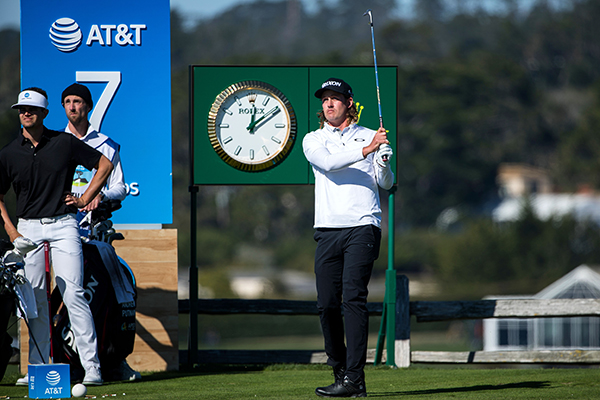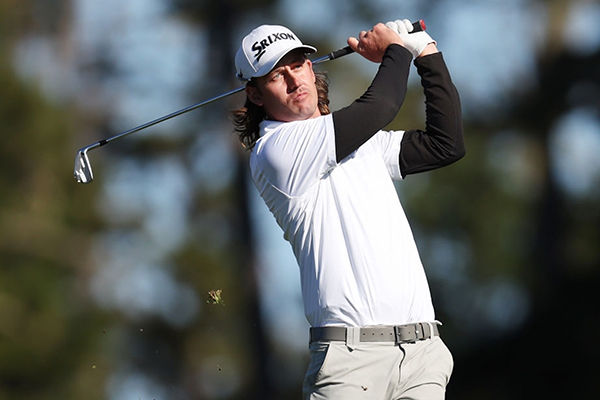by Garrett Johnston
It’s been a hit and miss season so far for Andrew Putnam, the PGA TOUR player from Tacoma, Wash. After a solid start to the 2021-22 wrap-around season, he had to deal with COVID in the winter and then got back in gear with a tie for sixth at the AT&T Pebble Beach Pro-Am in February. He then missed eight of 10 cuts before a top 15 in May’s Charles Schwab Challenge at Colonial. We spoke with the former WA Golf Player of the Year (2010) recently to catch up on his game and more.

How have you managed your expectations for this season?
I feel like I got off to a decent start. I didn’t really have high expectations to start with for this year as I didn’t get to practice a whole lot. I was happy with the way I started the fall part of the season and then in December I went through the whole COVID thing and kind of haven’t felt like I’ve gotten much out of my game the last few months. So that’s been really frustrating. My ball striking has been fairly decent but I haven’t been putting it all together. I feel like I’m starting to find some better form, I had a decent week in Colonial and it was awesome to qualify for the U.S. Open, that’s always a special thing, and it shows that my game’s trending in the right direction, but it’s been an up-and-down year.
You said you played well at Colonial – what did you take away from that top 15 finish?
Yeah, it was a mental battle, I had to get through that finish. I hadn’t made a cut in a while and the pressure really built just to get to the weekend and to make a check and prove to myself that I’m on the right track. So I just kind of fought through that adversity and made it through the weekend and I played really well on that Saturday. Sunday I didn’t have my best stuff but I felt great and I felt those feelings that I want to have on the golf course, feeling like you’re getting a lot out of your rounds and you’re maximizing your opportunities.
Speaking of feeling those feelings, you played in the final group at Pebble Beach in February, what was that experience like?
Yeah, obviously being in the final group always reveals a lot about where you’re at with your game and it teaches you a lot. It’s hard sometimes playing in the final group when you don’t really know where your game’s at, but I had a good result and I still finished with a top 6 and it was a confidence booster. I didn’t really get a lot out of the game in the months after that but glad it started trending again at Colonial in May.

What else are you trying to improve on these days with your game?
My putting has seemed to be pretty bad the second half of the season so far. I tend to be a great putter, so when that’s not going well it’s a different kind of frustration I haven’t felt in a long time. My accuracy off the tee has been decent, my length has been a little lower than I’ve wanted. If I’m close to even with strokes gained on my tee shots I should be in a good spot. My putting has been pretty dry. A lot of lip-outs and a lot of not making those putts inside of 10 feet that I usually make. That holds me back missing some of the crucial par putts and making those momentum putts. It’s tough, if you’re not scoring well on the tour there’s such a fine line. I’m just trying to get better with my putting,
How are you working on your putting to get back to where you want to be?
I actually had an old coach, Joe Thiel, who worked with me a little bit in Tacoma and gave me some advice, but nothing too crazy. My tempo might have been a little bit off with my putting stroke and just made a little set up change and that’s making a big difference.
What’s the set up change?
I am just focusing on getting a little bit closer to the ball and letting my arms hang a little more properly. That’s about it, keeping it very simple. He taught pretty much every good junior coming up out of Washington. He saw me the week before the Charles Schwab once to check on my putting. (Putnam then finished tied for 15th after missing eight of 10 cuts).
How would you like to give back to Washington Golf?
Me and my wife have been meeting with The First Tee of South Puget Sound and Washington Golf out of Tacoma. I think we’ll have some ideas of what new things we want to start in Washington but I can’t really reveal them yet as we haven’t formally put anything officially out there, but we’ll stay tuned on that. I’ve definitely been inspired to give back to the game that’s given me so much, especially the state of Washington, so we’re in the planning stages of that.
You played in your fourth U.S. Open in June. How proud are you to make it through?
I’m extremely proud. It’s always really tough to qualify. It’s always an extra layer of satisfaction when you make it through the qualifying process to get to a U.S. Open. Majors are really special, there’s a lot of people and a lot of buzz. The last handful of majors was during COVID when there wasn’t any fans so it left a little sour mark on my major experiences so I was happy to be back there in a U.S. Open where I could feel the energy of major championship golf.
Getting through a 36-hole U.S. Open qualifier – what’s the right approach?
The right attitude is to keep fighting. There’s so many up and down moments where you feel like ‘I messed that hole up, I’m not going to qualify.’ At the end of the day you get to the last few holes and the scores are not as low as you think they might be, so you just got to keep fighting through and be positive and that was my mindset this last time.
How did the U.S. Open at Brookline in June match up with your game? You tied for 31st.
I feel like it matched up pretty good. The greens were small and reminded me of Pebble Beach a lot and you know you got to hit it in the fairway at Brookline. I think the fairways were pretty generous for most U.S. Opens, but the greens were really slopey and undulating, making it very much a second shot golf course. The greens played even smaller than they really were so you had to manage your second shots coming in; that was the key to Brookline.
Garrett Johnston has covered golf for 10 years as a freelance writer. He also hosts the “Beyond the Clubhouse” podcast. Follow him at @JohnstonGarrett
